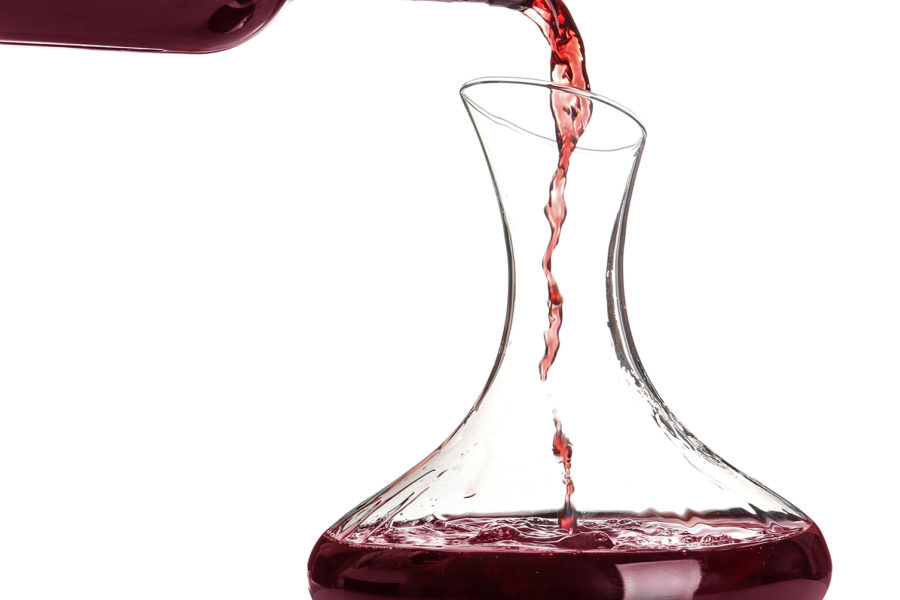
Pouring red wine into elegant decanter
Merriam-Webster defines the word decant as “to draw off (a liquid) without disturbing the sediment or the lower liquid layers.” It goes on to add “to pour (a liquid, such as wine) from one vessel into another.” Indeed, decanting older vintages that are suspected of having sediment housed in the basement of a bottle is the primary reason for straining the grit, solids and tiny particles such as grape skins and yeast from one vessel to another. However, that isn’t the only reason for pouring such fine wines into decanters or through aerating devices. Everyone who has enjoyed the art of drinking wonderful wines can easily and quickly raise hands in answering the second part of that question: What is the other reason for decanting? Oxidation and aeration, of course! Bringing out the best flavors and aromas at the most opportune time of that awesome bottle of full-bodied red is the answer. Ok, that was easy. Give me something more difficult, you say? What about taking a stab at answering if the process of decanting is truly that effective? Or is it just a cool thing to do among friends? To answer this, we’ll need to explore both sides.
Wine lovers have a tendency to humanize the whole decanting experience. We use terms such as allowing wine to ‘breathe.’ But does it afford this nectar to express its flavors more forcefully and more quickly? By permitting wine to oxidize, air unleashes the power of wine’s very essence and its very soul in the form of flavors and aromas. But what truly is the effect of oxidation from forcing certain wines to lay in wait, from several minutes to perhaps hours, in sometimes strange-looking vessels, before imbibing? Will aerating make that much of a difference? It depends, say some skeptics. And, some of those skeptics are wine professionals, including some master somms.
Some critics take the position that aerating certain wines could cause spoil, and may actually de-flavor wines rather than bring out the florals and bouquets that are expected to suddenly explode with the oxidation process. Some of these same cynics will further add that, in fact, a wine’s complex chemical composition will change with time and air, but can cause a wine to go flat over a very short duration through the early stages of the wine’s aeration development. The escape of two important but volatile compounds—hydrogen sulfide (H2S) and carbon dioxide (CO2)—can have a profound impact on how wine is weathered after opening. CO2 can make red wines tannic, but the presence of H2S can actually reduce some aromas quickly while being exposed to air. Knowing which wines, vintages and appellations are best to decant, and when, will provide the ultimate experience possible, say these critics.
We may know that some wine exposed to certain oxygen levels lead to specific chemical reactions, both pleasant and unpleasant. These changes take place over several minutes to hours following their opening. Wine will initially “open up”, if a high amount of acidity and tannins exist. Sulfur-based compounds in wine react quickly with oxidation. However, these are compounds we sometimes shouldn’t lose, such as those that are found in Sauvignon Blanc. The citric, tropical flavors and aromas can be easily lost when exposed to oxidation too long. Thus, this is the reason why many whites are not aerated when uncorked or should be drunk early and often in their lives.
Old wines can certainly go directly from the bottle right to the stemware, bypassing the decanter, unless sediment exists. Most of the tannins in older vintages such as in Barolo, Rioja, Bordeaux and Syrah wines are so supple that no decanting is necessary. Many of these will begin losing florals, aromas and deep flavors quickly if left in a decanter too long.
So, not all wines, particularly older reds, and most whites need to be decanted and exposed to the elements. These types of wines will not gain an advantage simply as a result of decanting. On the opposing side, younger reds with structure and more complexity, which tend to hold acidity and truly need to open up, would benefit tremendously from oxidation. Chemical reactions happen in all wines when exposed to aeration just after opening, and sometimes well into many hours of exposure. What ensues makes a real difference to the delightful flavors that change so dramatically given time in a decanter, providing completely different characteristics and yielding some vast changes in tastes that otherwise would have been lost without decanting. To argue that wines can’t benefit from this is a fallacy. The critical component is knowing the difference between what wines would be best left to breathe, and for when and how long. It is the point of argument made by those not always in favor of decanting. Some wines will lose their advantage if left to decant, and some will gain one.
So, before making that choice to pull one of those decanters sitting idly on your wine cellar shelf, be certain to review wine labels, winery, vintage and appellation. The choice to decant is a personal one, but could make the difference between enjoying a wonderful wine experience, or putting up with an average one, at best.
For comments, questions, suggestions and/or feedback, contact Robert Kennedy at rkj@Kennedy-companies.com.

